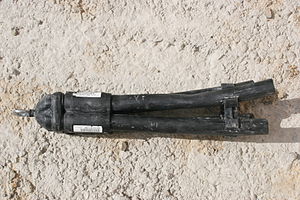A Look at Geothermal Heating from Heating and Air Cleveland
In the simplest interpretation, geothermal heating and cooling is using the earth's temp to heat and cool your residence. Pretty easy, no? Although the systems can be pricey to set up (particularly on a currently existing residence),
Heating and Air Cleveland says as soon as in spot there is a 30-70 % reduction in energy invoices for heating or cooling. Plus, there is no contamination or burning of fossil fuels, which is exceptionally essential in today's day and age.
 |
| English: Bottom end of a Downhole heat exchanger Deutsch: Unteres Ende einer Erdwärmesonde (Photo credit: Wikipedia) |
Below the earth's surface the temp tends to stay right around 55 degrees Fahrenheit. No matter just what the temperature exterior is, that temperature is rather steady. And geothermal energy utilizes this steady temp to cool your home in the summer and heat the residence in the wintertime. Kind of like radiant heating inside for your floor, channels are dug outside into the ground and pipes laid into them circulate water (or refrigerant) throughout the home-- one direction during the cold months to attract the warmer water and the other direction in the summer time to send the heat exterior and bring the cooler temp water inside.
Geothermal energy has been around for a long time-- also the Romans utilized to use it to heat up the water in their bathhouses. Natural warm springs you see on holiday are the outcome of geothermal energy. Some locations, like Iceland, have water so hot under the area that they can really make use of the steam to power buildings! Of course, this is natural geothermal energy and not the artificial kind we develop to utilize for our homes, but still-- you get the concept. From Climate.org, right here are some ways that we can easily access geothermal energy and what kinds it comes in:
- in hydrothermal tanks of steam or hot water trapped in rock. These tanks are focused in particular regions as an outcome of geologic procedures.
- in the heat of the shallow ground. Called "earth energy," this geothermal source is found everywhere and is the typical temp of the ground at shallow depths. Earth energy is not "boosted by" geologic process and therefore is not as hot as additional geothermal sources.
- in the hot dry rock discovered almost everywhere between 5-10 miles underneath the earth's area and at even shallower depths in areas of geologic event.
- in magma, thaw or partially thaw rock, that can easily reach temperatures of up to 1200 C or 2192 F. While some magma is discovered at obtainable depths, much of it lies too deep to be reached by existing modern technology.
- in geopressurized brines-- hot, pressurized waters having liquefied methane that are located 10,000 to 20,000 feet below the surface.
Each home and structure on the planet (well, where you can use geothermal) should be using this to heat and cool their open areas. Visualize if every home in your city could possibly be heated up and cooled making use of mainly just the earth's temp ... there would certainly be less pollution almost instantly! Supposedly, just by estimating for the houses making use of geothermal in this country as of today, it resembles the equivalent of decreasing our oil usage by 21 million barrels of oil per year. That is the the quantity that the U.S. eats in one day, however visualize if every house constructed from here on out made use of geothermal energy ... we could reduce our dependence on this unclean fossil fuel and decrease contamination in our environment at the exact same time. Heating and Air Cleveland has move information on their blog on the topic of
geothermal heating here.
 Set your thermostat between 78 and 80 degrees while in the home during the the summer time. Raise the temperature 7 degrees higher any time you leave the house for several hours. Raise the temperature 4 degrees higher when you go to sleep. It would be much better to use a programmable thermostat to make sure you won't need to manually change it throughout the day. Additionally, before you leave for traveling, turn your thermostat up to 85 degrees or higher in lieu of cooling the home when you are not planning on being home.
Set your thermostat between 78 and 80 degrees while in the home during the the summer time. Raise the temperature 7 degrees higher any time you leave the house for several hours. Raise the temperature 4 degrees higher when you go to sleep. It would be much better to use a programmable thermostat to make sure you won't need to manually change it throughout the day. Additionally, before you leave for traveling, turn your thermostat up to 85 degrees or higher in lieu of cooling the home when you are not planning on being home. 


